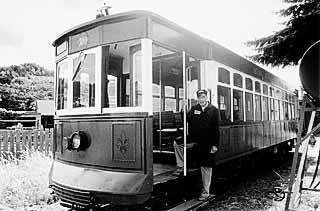Day Trips
San Antonio streetcar moves to the Northwest
By Gerald E. McLeod, Fri., Aug. 11, 2000

The bright red trolley's brass bell clangs at every intersection as it makes its way along the scenic business district. Once the pride of San Antonio's public transportation fleet, the polished railroad car now carries tourists on a 45-minute tour of the historic waterfront of Astoria, Oregon.
Built in St. Louis in 1914, Old Number 300, as the trolley is affectionately known, rumbled up and down the streets of the Alamo City for nearly 20 years. When the city began the conversion from steel wheels to rubber tires and diesel engines, the aging team of 25 electric trolleys was gradually retired.
"The San Antonio Public Service Company donated one of the trolleys to the San Antonio Museum Association to save for posterity," says Rachel Mauldin, Registrar of the San Antonio Museum of Art. She became the keeper of Old Number 300's history by virtue of accounting for the museum's assets.
For much of its life, the trolley served as a stationary classroom for artists at the Witte Museum and for a time resided in HemisFair Park. In 1981, the Museum Association refurbished the passenger car and ran it along the tracks on Jones Avenue, Mauldin says.
After three years of operation in San Antonio for a second time, Old Number 300 left Texas for Gales Creek, Oregon, where it was a working part of a trolley collection and railroad theme park.
When the mayor and city council members from Astoria discovered the coach in 1998, they found the roof rotting, and one whole wall was nearly gone. But the electric motor purred on the test ride and the delegation was sold on the idea of bringing the car to the banks of the Columbia River in northwestern Oregon.
It seems that Astoria has always wanted a trolley. The waterfront canneries were laced together with tracks that transported goods from the docks to Portland and the world beyond. In the 1880s, a city planner recommended Astoria add public transportation to the rails. He even drew a trolley that looked remarkably like Old Number 300, says Jeff Newenhof, an official with the Astoria Riverfront Trolley Association and owner of the City Lumber Company in Astoria.
The San Antonio museum loaned the trolley to the folks of Astoria under the condition that they fix it up and maintain it. Newenhof says that some of the parts for the trolley are still available. The wheels, axles, and rigging are pretty much standard. The roof is wood-covered with canvas and painted.
The trolley organization, comprised of 300 volunteers, spent more than 2,800 hours over five months rebuilding and restoring the 40-passenger car. Local craftsmen built anything the organization could not find to buy.
The trolley car is a work of art from the industrial revolution. The wooden backs of the seats swing back and forth on hinges to face either end of the car depending upon the preference of the passengers. The tall windows offer a nice breeze and spectacular views of the ships on the river or the historic homes that climb up the mountain. Instead of the overhead electrical wires, the trolley is powered by a generator towed at one end.
Beginning its new life in May 1999, Old Number 300 carries more than 2,000 riders a month, Newenhof says. While the motorman drives the trolley down the tracks between warehouses and new restaurants, the conductor helps passengers on and off and provides a narrative of the town's history.
Although its journey was a circuitous route, the little red trolley could not have asked for a better retirement home. Every afternoon between 3pm and 9pm (beginning at noon on weekends) the car makes the 3.5 mile trip from one end of historic Astoria to the other for $1 a ride.
On a spit of land between the mouths of the Columbia and Young rivers, this is the oldest American settlement west of the Mississippi River. Explorers went up the Columbia River as early as 1792, and Lewis and Clark spent the winter of 1806 nearby. But it was the fur traders sent by New York financier John Jacob Astor who established Fort Astoria on the steep mountainside.
From a frontier outpost, the seaport became an important fish-processing center and the second-largest town in Oregon in the early 1900s. The past is full of bawdy stories and fortunes made from the canneries and lumber. Astoria had a rough working reputation, while other towns along the coast were the summer resorts.
The town now is only slightly larger -- about 10,000 residents -- than it was when ships were lining up at the docks. The town has survived the passage of time remarkably well, even though a popular local bumper sticker claims: "We ain't quaint." Very few of the historic buildings have been replaced by fast food franchises, and most of the businesses are locally owned.
A little more than an hour's drive from Portland, Astoria is connected to Washington state by the four-mile-long and 200-foot-high Astoria-Megler Bridge. The waterfront is littered with the pilings that once held up the workings of a great fishing industry. The fading vestiges of commerce have left a beauty that Hollywood discovered for the filming of Kindergarten Cop, The Goonies, Teenage Mutant Ninja Turtles, Free Willy, and other movies and TV commercials.
For a small town at the northwestern tip of Oregon, Astoria has a surprisingly large number of attractions. To discover more about the area, call 503/325-6311 or go to www.oldoregon.com.
If you can't make it out west, at least visit "The Lure of the West" showing at the San Antonio Museum of Art through Aug.14. The exhibit consists of 64 paintings and sculptures from the Smithsonian American Art Museum collection. The San Antonio Museum, 600 W. Jones Ave., is world-renowned for its collection of antiquities, paintings, contemporary art, and the Nelson A. Rockefeller Center for Latin American Art. For more information, call 210/978-8100 or visit www.sa-museum.org.
Coming up this weekend ...
Festival of Trains in Dallas at Fair Park presents for public inspection a collection of locomotives and coaches that once ran on the Texas rails, Aug.12-13. 214/428-0101.








